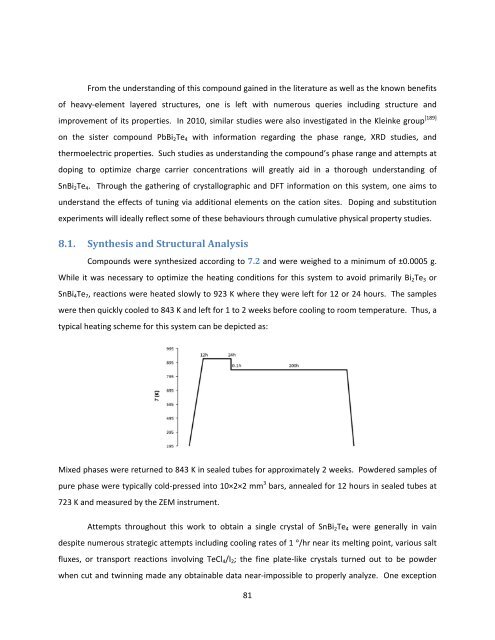Exploration and Optimization of Tellurium‐Based Thermoelectrics
Exploration and Optimization of Tellurium‐Based Thermoelectrics
Exploration and Optimization of Tellurium‐Based Thermoelectrics
You also want an ePaper? Increase the reach of your titles
YUMPU automatically turns print PDFs into web optimized ePapers that Google loves.
From the underst<strong>and</strong>ing <strong>of</strong> this compound gained in the literature as well as the known benefits<br />
<strong>of</strong> heavy‐element layered structures, one is left with numerous queries including structure <strong>and</strong><br />
improvement <strong>of</strong> its properties. In 2010, similar studies were also investigated in the Kleinke group [189]<br />
on the sister compound PbBi2Te4 with information regarding the phase range, XRD studies, <strong>and</strong><br />
thermoelectric properties. Such studies as underst<strong>and</strong>ing the compound’s phase range <strong>and</strong> attempts at<br />
doping to optimize charge carrier concentrations will greatly aid in a thorough underst<strong>and</strong>ing <strong>of</strong><br />
SnBi2Te4. Through the gathering <strong>of</strong> crystallographic <strong>and</strong> DFT information on this system, one aims to<br />
underst<strong>and</strong> the effects <strong>of</strong> tuning via additional elements on the cation sites. Doping <strong>and</strong> substitution<br />
experiments will ideally reflect some <strong>of</strong> these behaviours through cumulative physical property studies.<br />
8.1. Synthesis <strong>and</strong> Structural Analysis<br />
Compounds were synthesized according to 7.2 <strong>and</strong> were weighed to a minimum <strong>of</strong> ±0.0005 g.<br />
While it was necessary to optimize the heating conditions for this system to avoid primarily Bi2Te3 or<br />
SnBi4Te7, reactions were heated slowly to 923 K where they were left for 12 or 24 hours. The samples<br />
were then quickly cooled to 843 K <strong>and</strong> left for 1 to 2 weeks before cooling to room temperature. Thus, a<br />
typical heating scheme for this system can be depicted as:<br />
Mixed phases were returned to 843 K in sealed tubes for approximately 2 weeks. Powdered samples <strong>of</strong><br />
pure phase were typically cold‐pressed into 10×2×2 mm 3 bars, annealed for 12 hours in sealed tubes at<br />
723 K <strong>and</strong> measured by the ZEM instrument.<br />
Attempts throughout this work to obtain a single crystal <strong>of</strong> SnBi2Te4 were generally in vain<br />
despite numerous strategic attempts including cooling rates <strong>of</strong> 1 °/hr near its melting point, various salt<br />
fluxes, or transport reactions involving TeCl4/I2; the fine plate‐like crystals turned out to be powder<br />
when cut <strong>and</strong> twinning made any obtainable data near‐impossible to properly analyze. One exception<br />
81
















